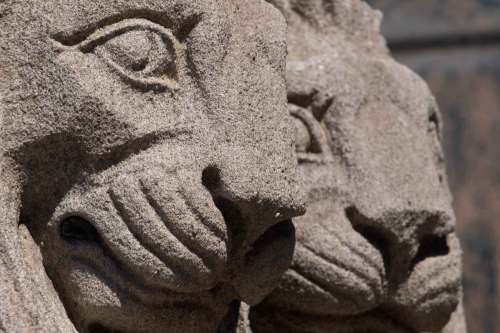
Carnegie Library - Braddock PA
Perhaps. But likely not anytime soon.
I first became aware of Braddock, PA last summer, through an article in my Google news alert from the People’s Weekly World (‘We take sides – Yours! Working class opinions and views since 1924’) entitled:
‘Future for the Mons Valley: “Hell doesn’t have to last forever”‘.
At first what amazed me was not Braddock – but that an old time leftie journal like People’s Weekly World still existed in today’s America. Or today’s anywhere, since our political conversation has shifted so rightward that what would have been centrist in the 70’s is now ‘radical’ left. But then I got interested in Braddock.
Braddock, Pennsylvania, sits just outside Pittsburgh, and has a population of 2800, down from 200,000 in the 50”s. The mayor, John Fetterman, has become a celebrity of sorts. Most recently, he was profiled in the Atlantic’s ‘Brave Thinkers’ series, but many papers have profiled him from the Guardian: America’s coolest mayor? to the New York Times: Rock Bottom For Decades but Showing Signs of Life. Fetterman makes great cop: a 6’8”, 300 pound, heavily tattooed white Harvard grad with a shaved head who wants to revive a dying steel town where the remaining population is mostly black. He seems a dedicated man, has built a website dedicated to the town braddoc; ‘destruction breeds creation – create amidst destruction’ (‘braddoc’ was the local Crips’ spelling of the town’s name).
Having grown up in a town surrounded by ghost towns and abandoned mines, a town that is itself almost now completely abandoned, I’ve always been fascinated by abandonment: what it means, what places become after they’ve been abandoned. But the story of Braddock and Mayor Fetterman’s attempts to revive it, struck other chords.

Abandoned Street, Braddock PA
In an excellent article from ReadyMade Magazine( ‘One Man’s Mission to Save Braddock, Pennsylvania’), the writers illustrate not only how black people were left behind by the GI Bill, by a lack of seniority in the workplace, but how Braddock is in the absurd position of possessing the last operating steel mill in the Valley, yet how almost no one works at the mill actually lives in Braddock. As Mayor Fetterman says, “the mill’s only contribution to the community is pollution – one of the main reasons white workers, when they could, moved out.”
The mayor would like to see the white folks come back. Not the white working class – no one expects that – but the only white folks who re-inhabit depressed urban areas their parents or grandparents fled – artists, urban frontierists, chasing cheap living spaces, an off-the-grid community, freedom, or sometimes just escape.
I’ve lived in some (albeit much tamer) version of Braddock since my teens – depopulated or recently de-industrialized neighborhoods occupied by the artists and misfits Fetterman wants to attract. Since about the mid-90’s, when it became apparent that cities like New York and London would have less and less space for people on the margins, I’ve thought real artistic renewal would come from smaller centres – like grunge came from Seattle. That hasn’t happened on any meaningful level, and cities seem to be separating into two types – gentrified and depressed (or semi-abandoned). The question remains – can any kind of real cultural movement form in places like Braddock (or Detroit, Buffalo . . .). And if they can, can they revive not just the city but the fortunes of the people who already live there, or resist the uber-gentrification (a little gentrification, like a little poison, can be a good thing) that seems to follow any cultural flowering?

Abandoned Department Store, Braddock PA
The Lower East Side is a half hour’s walk from the power centres of mid-town and Wall Street – even at its most abandoned and depraved, when drug lines circled around blocks of abandoned tenements, the separation was more psychological or cultural than physical. In many respects, New York was a more egalitarian place in those days, and drugs, art, thrills, formed the nexus where the powerful and the marginal rubbed shoulders. All those spaces I inhabited (or squatted), were in the heart of the city, in properties that are in some cases now worth millions.
It takes a certain kind of person to live off the grid, and the communities that formed were often riven by drugs, conflict, or an extreme (and crippling) marginalization. Isolation, drugs, blightend landscapes, crime – these aren’t easy to take day after day, especially as you get older.

Another street - Braddock, PA
What else are communities like Braddock to do? Unless the West re-industrializes (and there seems to be a growing awareness that this might be a good idea), there isn’t much that can be done. The solution that is proposed again and again for depressed communities seems to be big box malls, gambling or a prison – Fetterman’s opponent in the last election wanted to bring in a gas station. The homesteaders provide population, new ideas, energy. Maybe, as our economy changes, the inevitability of gentrification for successful cultural communities will change as well. Maybe new industries will one day come back to Braddock . . .
In the meantime, Braddock remains an experiment worth watching. Even if it doesn’t become the next Lower East Side. And if it is successful, perhaps my little town will attract people in like fashion one day . . .
 Uranium City, Saskatchewan, where I grew up. Empty buildings stretch for three or four miles
Uranium City, Saskatchewan, where I grew up. Empty buildings stretch for three or four miles
More articles:
former steeltown
From the Monthly Review: Braddock, Pennsylvania – Out of the Furnace, Into the Fire
Thread in city-data.com about Braddock, mostly from people from neighboring areas
Read Full Post »
 Image: Jefft
Image: Jefft




















Braddock, Pensylvania – the next Lower East Side?
Posted in Comment, Culture, Gentrification, Observations, Sunday Feature, tagged Abandoned Towns, Braddock, Lower East Side, Underground culture on March 7, 2010| 8 Comments »
Carnegie Library - Braddock PA
Perhaps. But likely not anytime soon.
I first became aware of Braddock, PA last summer, through an article in my Google news alert from the People’s Weekly World (‘We take sides – Yours! Working class opinions and views since 1924’) entitled:
‘Future for the Mons Valley: “Hell doesn’t have to last forever”‘.
At first what amazed me was not Braddock – but that an old time leftie journal like People’s Weekly World still existed in today’s America. Or today’s anywhere, since our political conversation has shifted so rightward that what would have been centrist in the 70’s is now ‘radical’ left. But then I got interested in Braddock.
Braddock, Pennsylvania, sits just outside Pittsburgh, and has a population of 2800, down from 200,000 in the 50”s. The mayor, John Fetterman, has become a celebrity of sorts. Most recently, he was profiled in the Atlantic’s ‘Brave Thinkers’ series, but many papers have profiled him from the Guardian: America’s coolest mayor? to the New York Times: Rock Bottom For Decades but Showing Signs of Life. Fetterman makes great cop: a 6’8”, 300 pound, heavily tattooed white Harvard grad with a shaved head who wants to revive a dying steel town where the remaining population is mostly black. He seems a dedicated man, has built a website dedicated to the town braddoc; ‘destruction breeds creation – create amidst destruction’ (‘braddoc’ was the local Crips’ spelling of the town’s name).
Having grown up in a town surrounded by ghost towns and abandoned mines, a town that is itself almost now completely abandoned, I’ve always been fascinated by abandonment: what it means, what places become after they’ve been abandoned. But the story of Braddock and Mayor Fetterman’s attempts to revive it, struck other chords.
Abandoned Street, Braddock PA
In an excellent article from ReadyMade Magazine( ‘One Man’s Mission to Save Braddock, Pennsylvania’), the writers illustrate not only how black people were left behind by the GI Bill, by a lack of seniority in the workplace, but how Braddock is in the absurd position of possessing the last operating steel mill in the Valley, yet how almost no one works at the mill actually lives in Braddock. As Mayor Fetterman says, “the mill’s only contribution to the community is pollution – one of the main reasons white workers, when they could, moved out.”
The mayor would like to see the white folks come back. Not the white working class – no one expects that – but the only white folks who re-inhabit depressed urban areas their parents or grandparents fled – artists, urban frontierists, chasing cheap living spaces, an off-the-grid community, freedom, or sometimes just escape.
I’ve lived in some (albeit much tamer) version of Braddock since my teens – depopulated or recently de-industrialized neighborhoods occupied by the artists and misfits Fetterman wants to attract. Since about the mid-90’s, when it became apparent that cities like New York and London would have less and less space for people on the margins, I’ve thought real artistic renewal would come from smaller centres – like grunge came from Seattle. That hasn’t happened on any meaningful level, and cities seem to be separating into two types – gentrified and depressed (or semi-abandoned). The question remains – can any kind of real cultural movement form in places like Braddock (or Detroit, Buffalo . . .). And if they can, can they revive not just the city but the fortunes of the people who already live there, or resist the uber-gentrification (a little gentrification, like a little poison, can be a good thing) that seems to follow any cultural flowering?
Abandoned Department Store, Braddock PA
The Lower East Side is a half hour’s walk from the power centres of mid-town and Wall Street – even at its most abandoned and depraved, when drug lines circled around blocks of abandoned tenements, the separation was more psychological or cultural than physical. In many respects, New York was a more egalitarian place in those days, and drugs, art, thrills, formed the nexus where the powerful and the marginal rubbed shoulders. All those spaces I inhabited (or squatted), were in the heart of the city, in properties that are in some cases now worth millions.
It takes a certain kind of person to live off the grid, and the communities that formed were often riven by drugs, conflict, or an extreme (and crippling) marginalization. Isolation, drugs, blightend landscapes, crime – these aren’t easy to take day after day, especially as you get older.
Another street - Braddock, PA
What else are communities like Braddock to do? Unless the West re-industrializes (and there seems to be a growing awareness that this might be a good idea), there isn’t much that can be done. The solution that is proposed again and again for depressed communities seems to be big box malls, gambling or a prison – Fetterman’s opponent in the last election wanted to bring in a gas station. The homesteaders provide population, new ideas, energy. Maybe, as our economy changes, the inevitability of gentrification for successful cultural communities will change as well. Maybe new industries will one day come back to Braddock . . .
In the meantime, Braddock remains an experiment worth watching. Even if it doesn’t become the next Lower East Side. And if it is successful, perhaps my little town will attract people in like fashion one day . . .
More articles:
former steeltown
From the Monthly Review: Braddock, Pennsylvania – Out of the Furnace, Into the Fire
Thread in city-data.com about Braddock, mostly from people from neighboring areas
Read Full Post »